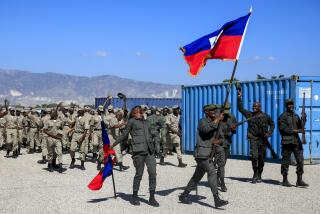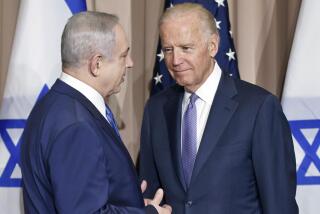Intervention May Not Stop Rights Abuse
PORT-AU-PRINCE, Haiti — The new outbreaks of violence against citizens by the Haitian military on Tuesday expose a potential flaw in the Clinton Administration’s Haitian peace accord--that it may have no effective plan for quelling the human rights violations that were a major reason for U.S. intervention.
Indeed, U.S. military officials concede, the last-minute agreement obtained by the peace mission headed by former President Jimmy Carter has forced American troops into an awkward partnership with the repressive Haitian military and police forces they originally had planned to overwhelm and replace.
As a result, these officials say, U.S. troops now must seek to “co-opt” the 7,000-member Haitian military gradually--hoping eventually to coax the Haitian army and police force into making reforms, even though that means allowing some measure of Haitian-against-Haitian violence to continue, at least for the short run.
“The task of keeping law and order in Haiti is the responsibility of the Haitian police force and the Haitian military,” U.S. Army Gen. John M. Shalikashvili, chairman of the Joint Chiefs of Staff, told reporters in Washington. “We are not in a business of doing the day-to-day law and order, for that matter resolving or quelling any demonstrations. . . .”
But senior U.S. officials admit that the approach contains risks that may well unravel the entire democratization plan. To begin with, the current policy, under which U.S. troops would have to stand by even while ordinary Haitians are beaten or shot at, fosters the perception that the Americans are backing the police--and could prompt a backlash against U.S. forces.
Shalikashvili himself publicly conceded Tuesday that the hands-off policy eventually could backfire on U.S. forces, acknowledging that the Haitian-on-Haitian violence contains a “murky sort of threat” that could end up in “explosive situations.” U.S. soldiers “have to be prepared for it,” he said.
At the same time, U.S. officials are fearful that the increasing appearance of such incidents on American television screens could well prove politically unsustainable in the United States, sparking public outrage that could intensify pressure on Congress to force the Administration to get out of Haiti early.
Moreover, some strategists are predicting that the incidence of beatings and shootings--which are daily fare in Haiti but probably unacceptable on American TV screens--is almost certain to increase sharply as the Oct. 15 deadline for the departure of the army commander, Lt. Gen. Raoul Cedras, approaches.
The criticism already has begun in the wake of Tuesday’s incidents. Pierre Sane, secretary general of Amnesty International, issued a statement saying the “impunity for human-rights violators granted in the agreement between the U.S. government and the Haitian military puts that country’s population in immediate danger.”
“Letting killers and torturers (in the Haitian army) off the hook undermines long-term solutions to the country’s continuing human rights crisis because it sends a message that they can continue their abuses,” Sane said in a speech delivered at United Nations headquarters in New York.
The original invasion plan that the Administration had begun carrying out on Sunday would have resolved that aspect of the Haitian problem. The operations order called for U.S. troops to overpower the Haitian military and police forces and to take over all responsibility for keeping order in the country.
But the arrangements dictated by the Carter accord--while making it easier for U.S. troops to enter the country--require U.S. commanders to cooperate with the Haitian military and police forces and leave to them the bulk of the responsibility for day-to-day police action.
That means that U.S. troops simply are not to intervene to stop Haitian police or militiamen from beating or even shooting ordinary Haitians, unless the violence becomes so widespread that it threatens the general stability of the country.
It also means that except in cases in which U.S. troops feel that they are being threatened, the Americans will not aggressively disarm Haitian units or individuals. Instead, U.S. personnel will try to persuade Haitian military leaders to recall unauthorized weapons. And they may finance a weapons buyback program to encourage Haitians to turn in their arms voluntarily.
The plan for overhauling the Haitian military is a slow one by any standard--and an iffy one. A senior Pentagon official said Tuesday that the U.S. military hopes gradually to win the confidence of the Haitian military sufficiently to coax it into making some reforms, or at least into taking steps that may ultimately lead to more serious changes.
“It’s going to take a hell of a lot longer” than overwhelming and replacing the Haitian military would have, he said.
One such scheme calls for prodding the Haitians to provide members of the military and police forces with photo identification cards, keeping better track of their weapons and paying them with funds provided by the U.S. Agency for International Development to tie them more closely to U.S. influence. U.S. military police officers also could accompany them to serve as examples.
But the official warned that with the long history of police abuses and violence in Haiti, “you’re not going to change Haitian society overnight.” Haiti has a society “that lives by intimidation,” he said. He charged that critics want to establish a standard of violence-control “that you can’t meet in Los Angeles.”
The issue of disarmament also is a touchy one in Haiti. Although the army, which is equipped with Israeli-made assault rifles and other lesser weapons, is so poorly armed that it is not considered a threat to the U.S. occupation force, hundreds of thousands of civilians are believed to have weapons ranging from target pistols to grenade launchers.
Security experts say “thousands and thousands” of Haitians have guns, including civilian auxiliary police forces called attaches , who are widely regarded as terror squads and who carry out the worst of the military’s brutal oppression. “The really dangerous people have M-16s, 9-millimeters and all sorts of heavy firepower,” one said.
Those weapons have been in evidence recently as groups of civilians, mostly young men in their 20s and 30s, have taken over nighttime roadblocks, threatening foreign reporters and promising to punish pro-democracy Haitians. “The army has handed out at least 3,000 rifles to its attaches and other civilian supporters over the last three months,” one expert said.
Even those Haitians who criticize the country’s military say the U.S. plan to buy up civilian-held firearms is unlikely to work. “You’re not going to buy back these weapons,” one said when told of the American scheme. “These people . . . think their lives depend on their guns. What you’ll get are rusty pieces of junk and useless stuff.”
But some Western observers contend the disarmament plan could work. While U.S. forces may be keeping the issue low-key right now, if disarmament becomes necessary “the guns will be brought in, at least most of them,” one said.
In 1987, when the Haitian army sought to dismantle the Tontons Macoutes, the 55,000-member private security forces of the deposed Duvalier family, it simply ordered their weapons turned in.
More to Read
Sign up for Essential California
The most important California stories and recommendations in your inbox every morning.
You may occasionally receive promotional content from the Los Angeles Times.










